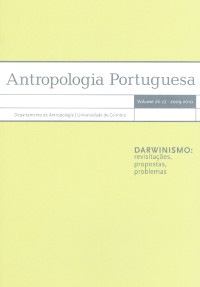Please use this identifier to cite or link to this item:
https://hdl.handle.net/10316.2/28676| Title: | O contributo da genética para a evolução do pensamento evolutivo | Authors: | Alvarez, Manuela | Keywords: | Darwinian evolution;Mendelian genetics;population genetics;modern synthesis;neutral evolution;genomics;Evolução darwiniana;genética mendeliana;genética das populações;síntese moderna;evolução neutral;genómica | Issue Date: | 2010 | Publisher: | CIAS - Centro de Investigação em Antropologia e Saúde | Abstract: | In the year of 1859, Darwin explained why surviving individuals, which
vary in some way that enables them to live longer and reproduce, pass on their
advantage to succeeding generations. However, he could not account for how
traits were passed down from generation to generation, which bring the problem
of heredity to the forefront of evolutionary biology. In the 1930s and 1940s Mendelian
inheritance was combined with Darwin’s theory of natural selection. From
this combination emerged the theory of population genetics that crystallized in the
Synthetic Theory of Evolution, also referred to as the Modern Synthesis, which
has become the current evolutionary paradigm of modern biology. In the mid 60s
and late 90s genetics undergone two major technological and conceptual revolutions:
the molecular revolution, and the “omics” revolution. Both provided new
information on organism’s macromolecules variation level, and new insights on the forces responsible for their origins. The purpose of this article was to provide
a brief recapitulation of the conceptual advances made on genetics during the 20th
century, and its impact on the history of evolutionary theory. Em 1859 Darwin explicou porque é que as mudanças operadas num organismo, proporcionando uma melhor sobrevivência e reprodução, são transmitidas de geração em geração até se fixarem na população. Porém, Darwin não conseguiu explicar como se processava esta transmissão entre gerações, colocando o problema da hereditariedade na vanguarda da biologia evolutiva. Nos anos 30 e 40 do século XX, a hereditariedade de Mendel foi combinada com a teoria da selecção natural de Darwin para dar origem à genética das populações que, alguns anos mais tarde, viria a cristalizar na Síntese Moderna ou Teoria Sintética da Evolução, que constitui o paradigma evolutivo actual da biologia moderna. Na segunda metade do século, a genética sofreu duas grandes revoluções tecnológicas e conceptuais, a revolução molecular e a revolução “ómica”, que permitiram conhecer a diversidade dos organismos ao nível dos genes e dos genomas, e colocar novas hipóteses sobre os mecanismos genéticos e evolutivos que lhe deram origem. O propósito deste artigo foi descrever, sinteticamente, os avanços conceptuais sofridos pela genética ao longo do século XX e o seu impacto na história do pensamento evolutivo. |
URI: | https://hdl.handle.net/10316.2/28676 | ISSN: | 2182-7982 | DOI: | 10.14195/2182-7982_27_7 | Rights: | open access |
| Appears in Collections: | Antropologia Portuguesa |
Files in This Item:
| File | Description | Size | Format | |
|---|---|---|---|---|
| ap26-27_artigo8.pdf | 1.56 MB | Adobe PDF |  |
Items in DSpace are protected by copyright, with all rights reserved, unless otherwise indicated.
